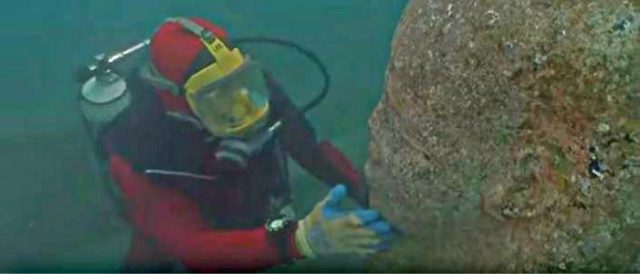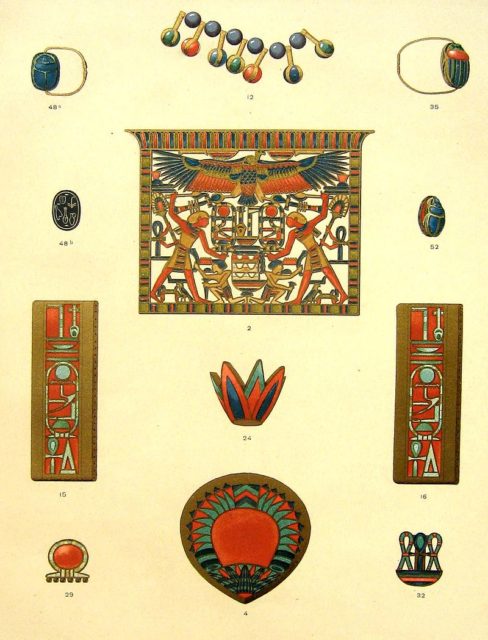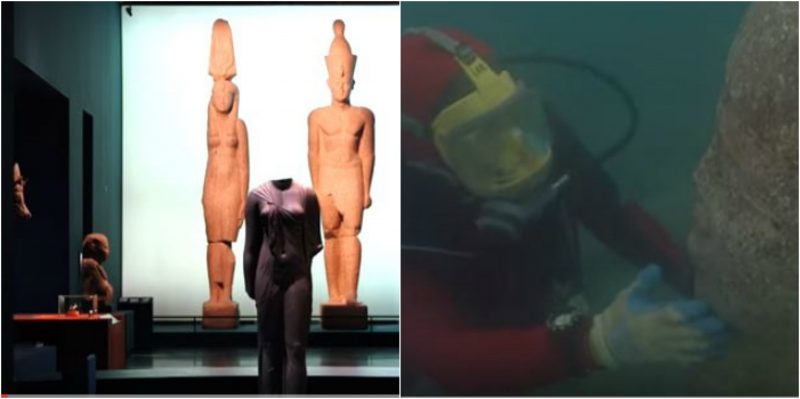On May 19th, 2016, the British Museum in London, England, opened a new exhibition showcasing the sunken cities of ancient Egypt. The “Lost Worlds” exhibition contains artifacts that have lain beneath the Mediterranean seabed for thousands of years, but have now been recovered and restored to their former magnificence.

The treasures found include towering statues, golden jewelry that had been worn by pharaohs, and hieroglyphic tablets. Their rediscovery brought a collective sigh of relief from experts, who had feared such artifacts had been lost permanently. Experts had suspected the existence of such artifacts underwater off the modern Egyptian coast, because there had been references to two settlements in the area, called Heracleion and Canopus, in many ancient texts.
Heracleion and Canopus had been essentially the gateway to Egypt; before, of course, the rise of the famous city of Alexandria. Both cities had been precariously built on the shifting ground of the Nile Delta. Around 800 AD, both settlements were lost, literally, to the sands of time and were buried beneath 10 feet (3 meters) of silt. They were not disturbed by the outside world until 1996. The ruins of Canopus are located two kilometers east of the western fringe of the Nile Delta, in Aboukir Bay.
Franck Goddio is the president of the European Institute of Underwater Archeology and the co-curated of the exhibition. He is clearly very passionate about the subject. “My team and I, as well as the Hilti Foundation, are delighted that the exhibition with discoveries from our underwater archaeological expeditions off the coast of Egypt will be on display at the British Museum.” He said, “It enables us to share with the public the results of years of work at the sunken cities and our fascination for ancient worlds and civilizations. Placing our discoveries alongside selected masterpieces from the collections of Egyptian museums, complemented by important objects from the British Museum, the exhibition presents unique insights into a fascinating period in history during which Egyptians and Greeks encountered each other on the shores of the Mediterranean.”

The pioneering European team’s success in recovering so many artifacts is partially due to their partnership with the Egyptian Ministry of Antiquities, and partially due to the state-of-the-art technologies. This task was not an easy or quick one. It has taken the better part of two decades for the team, using scuba gear, to painstakingly dredge the seabed for lost artifacts.
The location of the two ancient cities means that the artifacts being found are an interesting mix of Egypt and Ancient Greece cultures. This is not an unusual phenomenon amongst Nile Delta cities due to the amount of foreign trade in the region. Researchers often find an interchange between the two cultures.
In the exhibition, more than 300 items will be put on display. Many of these were pulled from the sunken ruins. In this case, that was lucky that they were buried in silt and underwater; it was precisely those conditions that allowed such a large number of artifacts to remain remarkably well preserved.
Although not all of the artifacts can be listed here, there were a quite a few highlights that were discovered. A six foot (1.9 meter) hieroglyphic tablet found had an inscription of a royal declaration from Pharaoh Nectanebo I. A colossal statue of Hapy, made out of red granite, was found. Hapy was an Egyptian god who personified the Nile’s flood and symbolized abundance and fertility. Standing at 5.4 meters tall, such a statue of this size of this particular god has ever been found, and experts believe that it might have decorated the temple of Thonis-Heracleion.
Speaking of Thonis-Heracleion, the Stele of that temple has also been recovered. Measuring 1.9 meters, it is inscribed with the decree of Saϊs and was commissioned by Nectanebos I, who ruled from 378 to 362 BC. Interestingly, this stele is almost identical to the Stele of Naukratis that now resides in the Egyptian Museum in Cairo.
Among the many statues are a statue of Osiris, dating from the seventh century BC, a statue of the bull god Apis, on loan from the Greco-Roman Museum in Alexandria, and a statue of Arsinoe II, a queen from the Ptolemaic dynasty – the dynasty that was founded after Alexander the Great conquered the country. She is dressed as the goddess Isis.
Divers also found gifts intended for the gods. They found several model boats that were metal replicas of the tiny papyrus vessels used by Egyptians as offerings. These papyrus boats would have set sail at the temple of Amun-Gereb.
Fantastic pieces of jewelry were recovered as well. One necklace, called a pectoral, is decorated with lapis lazuli and glass and is also on loan from the Egyptian Museum. Yet another interesting find was a youthful posthumous portrait of Alexander the Great. Naturally, other types of artifacts have been found among the ruins. For example, the jaw bones of cows have been found.

As readers probably have noted, some of the items in the show are on loan. This is an unusual concession from the Egyptian authorities, as they rarely let such items leave their country. The exhibition, called Sunken Cities: Egypt’s Lost World, will run from 9 May to 27 November in the British Museum, in London, England.
